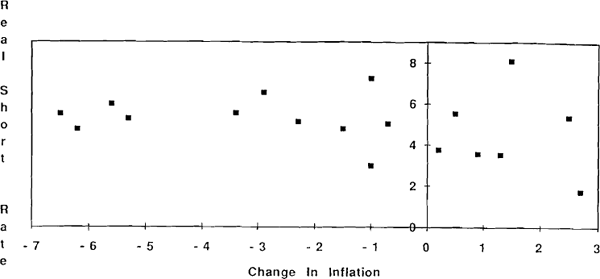RDP 9104: Cross-Country Relationship Between Interest Rates and Inflation over Three Decades 4. A Simple Test
June 1991
- Download the Paper 929KB
This section attempts to determine whether the high short-term real interest rates in high inflation countries represent an attempt to decrease inflation or whether they are simply keeping inflation steady. Table 1 and Graph 20 look at this. If it is the case that high inflation countries were running tighter monetary policies, we might expect the observations in Graph 20 to lie approximately in a downward sloping line: countries with high real interest rates having made the most progress on inflation.
| Interest Rate(%pa) | Change in inflation* | |
|---|---|---|
| New Zealand | 8.1 | 1.5 |
| Australia | 7.2 | −1.0 |
| Norway | 6.5 | −2.9 |
| Ireland | 6.0 | −5.6 |
| Italy | 5.5 | −6.5 |
| Canada | 5.5 | 0.5 |
| Belgium | 5.5 | −3.4 |
| United Kingdom | 5.4 | 2.5 |
| Spain | 5.3 | −5.3 |
| Sweden | 5.1 | −2.3 |
| Denmark | 5.0 | −0.7 |
| The Netherlands | 4.8 | −1.5 |
| France | 4.7 | −6.2 |
| Germany | 3.8 | 0.2 |
| Japan | 3.6 | 0.9 |
| United States | 3.5 | 1.3 |
| Austria | 3.0 | −1.0 |
| Switzerland | 1.7 | 2.7 |
* Four-quarter-ended percentage change in the CPI in December 1989 less the four-quarter-ended percentage change in the CPI in December 1983. A positive (negative) number implies an increase (decrease) in inflation. |
||

There is some evidence of a negative relationship. An OLS regression through these points yields a slope coefficient of −0.52 but it is insignificantly different from zero. Australia, New Zealand[12] and the United Kingdom all had high real short-term interest rates on average over this period but inflation only fell slightly in Australia and rose in the other two countries. On the other hand, Italy, Ireland and France all had average real interest rates around the same level as the United Kingdom but they achieved large reductions in inflation. It is interesting to note that these three countries were all EMS members over this period. The large reductions in inflation with the same level of real interest rates as the UK may be evidence of “credibility” achieved by participation in the exchange rate mechanism.
Table 1 indicates that of the five countries with the highest real interest rates over the period all achieved declines in inflation except for New Zealand. Given the distortions in the New Zealand inflation data, it would not seem unreasonable to exclude New Zealand from the comparisons. Excluding New Zealand from the regression between the change in inflation and the average real interest rate yields a coefficient of −1.04 and it is significantly different from zero. This is evidence in favour of the hypothesis that the high real interest rates in high inflation countries are fighting inflation.
On the other hand, some of the observations for individual countries support the idea that the high real interest rates were simply stopping inflation from accelerating. If we take the world real interest rate to be the average of those for the US, Germany and Japan (which are all around 3½per cent per annum) Australia, Canada and Denmark all ran real pre-tax interest rates above the world real interest rate and had close to no progress on inflation. The smaller European countries have generally run their interest rates above the world rate and achieved varying progress on inflation. New Zealand and the UK have experienced a rise in inflation, despite running pre-tax real interest rates above the world rate.
So the simple test used here cannot determine which of the two hypotheses might be correct. The problem is that it is difficult to establish whether the real interest rate in a country is higher than, equal to or less than the real interest rate which would keep inflation steady (the “steady inflation” interest rate). It is this differential which determines whether policy is “tight” or not, rather than the absolute level of the real interest rate.
A further note of caution; there could also be problems with the lags between interest rates and inflation. Real interest rates may be high on average because of a very tight policy toward the end of the period. In this case, the impact on inflation may not have shown up within the period. For example, in 1990 inflation eventually fell in Australia, the UK and New Zealand. If Table 1 and Graph 20 were extended to include another year, these countries would show more progress on inflation for their high real interest rates.
Footnote
Price controls early in the period distort the picture. [12]